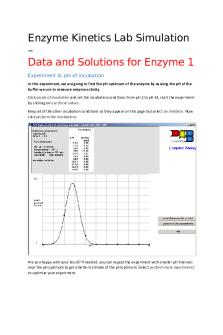Enzyme Kinetics - Lecture notes 1 PDF

| Title | Enzyme Kinetics - Lecture notes 1 |
|---|---|
| Author | James Davies |
| Course | Biological Chemistry |
| Institution | Cardiff University |
| Pages | 2 |
| File Size | 60.8 KB |
| File Type | |
| Total Downloads | 324 |
| Total Views | 376 |
Summary
Enzyme KineticsCatalysts: make reaction happen faster without being used upWork under mild conditionsSpecific for both reaction they carry out e. phosphorylation, and specific to what substrateCan be regulated e. regulating our metabolismE+S ES E+P Substrate binds to enzyme (rapidly reversible prose...
Description
Enzyme Kinetics Catalysts: make reaction happen faster without being used up Work under mild conditions Specific for both reaction they carry out e.g. phosphorylation, and specific to what substrate Can be regulated e.g. regulating our metabolism E+S
ES
E+P
1. Substrate binds to enzyme (rapidly reversible proses) 2. Reaction occurs and product(s) dissociate Substrate Concertation
Slow reaction at low [S] because of far more active sites compared to substrates, less successful collisions Fast reaction at high [S] because of plentiful supply of substrate for active sites to binds to, far more successful collisions per unit time and product production will increase until saturation
Rate of product formation can be measured by absorbance
Low [S] causes a low absorbance Higher [S] causes a high absorbance Higher [S] causes a higher absorbance however does reach saturation (all active sites are being used up and product formation cannot increase) Measure the initial velocity (v)- the velocity at the start of the reaction Plot graph (v) against [S] which will describe the relationship Vmax is the velocity at saturation Km is the [S] that is a velocity of Kmax/2
K1 E+S
Kcat ES
E+P
K2 Kcat= catalytic constant (describes how fast it works) Usually Kcat is much smaller than K2 Rate of formation of P is proportional to [ES] Rate of change of [P]=Kcat.[ES] Vmax=Kcat.[Etot] Km (describes its substrate concentration dependence) Best measure of an enzymes catalytic efficiency=Kcat/Km (specificity constant)
For a good enzyme Kcat is high For a good enzyme Km is low For good enzyme Kcat/Km is high
Enzymes Facilitate Reactions
Facilitating the making/breaking of bonds (electron redistribution)
Enzyme Inhibition Transition State
Inhibitors are inhibitors of the transition state
Reversible Inhibition (Competitive)
Inhibitor competes with a substrate to bind with the active site Reversible reaction Does not change the configuration of the active site Inhibitor and substrate can’t be active at the same time Recognised by lower velocity at same [S] However at high enough [S] you can still saturate the system and therefore Vmax can still be reached, however at a slower rate The [S] required to produce Vmax/2 had increased Ki= inhibitor constant KmApp=Km.(1+[I]/Ki)
Irreversible Inhibition
Enzymes can be irreversible inhibited by compounds that react covalently with groups within the enzyme that are essential to the enzymes activity Covalent modification E+I EI Vmax has decreased therefore 1/Vmax has increased Doesn’t change Km
Use of Inhibitors in Disease
Myasthenia gravis -progressive muscular weakness -problem at neuromuscular junction You could increase [acetylcholine] to relieve symptoms Inhibit acetylcholinesterase with Edrophonium-used as a diagnostic however is metabolised quickly Treat with Neostigmine – irreversible inhibition of acetylcholinesterase by forming a covalent bond...
Similar Free PDFs

Lecture Notes 1 Kinetics
- 32 Pages

Mcat biochem Enzyme Kinetics
- 3 Pages

Tutorial Enzyme Kinetics
- 8 Pages

05 Enzyme kinetics - Worksheet
- 18 Pages

Lab #9 Enzyme Kinetics
- 10 Pages

Lab Report - Enzyme Kinetics
- 4 Pages

Enzyme Kinetics Lab Simulation
- 4 Pages

Enzyme Kinetics Lab Report
- 14 Pages

Chemical Kinetics - Lecture notes 1
- 23 Pages
Popular Institutions
- Tinajero National High School - Annex
- Politeknik Caltex Riau
- Yokohama City University
- SGT University
- University of Al-Qadisiyah
- Divine Word College of Vigan
- Techniek College Rotterdam
- Universidade de Santiago
- Universiti Teknologi MARA Cawangan Johor Kampus Pasir Gudang
- Poltekkes Kemenkes Yogyakarta
- Baguio City National High School
- Colegio san marcos
- preparatoria uno
- Centro de Bachillerato Tecnológico Industrial y de Servicios No. 107
- Dalian Maritime University
- Quang Trung Secondary School
- Colegio Tecnológico en Informática
- Corporación Regional de Educación Superior
- Grupo CEDVA
- Dar Al Uloom University
- Centro de Estudios Preuniversitarios de la Universidad Nacional de Ingeniería
- 上智大学
- Aakash International School, Nuna Majara
- San Felipe Neri Catholic School
- Kang Chiao International School - New Taipei City
- Misamis Occidental National High School
- Institución Educativa Escuela Normal Juan Ladrilleros
- Kolehiyo ng Pantukan
- Batanes State College
- Instituto Continental
- Sekolah Menengah Kejuruan Kesehatan Kaltara (Tarakan)
- Colegio de La Inmaculada Concepcion - Cebu






